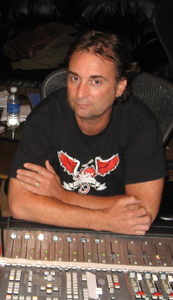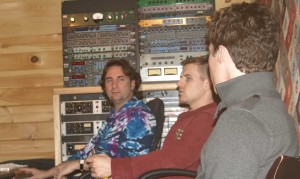Rick Slater’s Deconstructing the Project — Pre-Pre-Production
First in a series of in-studio tutorials by Rick Slater, NYC Producer/Engineer/Warrior.
MIDTOWN, MANHATTAN: If you keep an open mind, the music will tell you what to do. That’s been my philosophy in the studio, one of the many hard-learned lessons I’ve learned over many years of engineering records. I’ve seen and tried many interesting methods of manipulating sound, and I’ve also seen that sometimes the best thing you can do as an engineer/producer is stay out of the way and be a documentarian.

Rick Slater is listening...
And it’s not for lack of sonic curiosity — I started playing with tape loops as a compositional tool in sixth grade music class. That’s what got me hooked, that and Aerosmith’s Toys in the Attic. I got to NYC and got a job at Mediasound Studios and eventually weaseled my way up to some engineering before the doors closed. My last staff job would be Quad Recording in its heyday. I’ve eagerly learned from masters of the craft who, in turn, have helped me craft my own approach.
When at Mediasound, I was always encouraged by everyone to ask questions (at the appropriate time). Some of the greats, like Michael Brauer, Steve Thompson, Mike Barbiero, and Ed Stasium, would let you watch them work, and answer your questions. Unfortunately professional audio has changed and many up-and-coming engineers are opening new doors into audio but don’t get the chance to learn the lessons of the past.
In this series of short articles I’ll take a look at some insights I’ve picked up in my time in the studio, and take you, step-by-step through a record project. It would be great to see some folks respond with their stories. In this spirit we can all share and advance our craft.
I’ll start at the beginning: as in, Day One: an artist has decided to work with me.
If it’s a production, then I need to identify which songs speak to me as the listener and see how that lines up with the artist’s list of favorites. If I’m just engineering I still like to have a feel for the material. I’ll try to get a feel for what the songs mean to the artist and what motivates the artist. At this point I’m thinking of the type of environment that would best elicit a great performance, the gear I need to support the endeavor, and what kind of budget I have to do it in. I start looking for what I think may need to be tweaked in the arrangement and what tempos feel best. I listen for key and see if it’s the most exciting key and if it’s a good range for the singer. Soon the files and emails are flying back and forth.
Once we have all this nailed down it’s time to record some rehearsals. I never get fussy over audio quality here; I just want to focus on performance. I do stress that everyone playing must be able to hear everyone else when they play. You’d be surprised how much house cleaning gets done at this stage.
I once was working with a rock/pop group from RI. They had practiced a lot but because of the distance and their busy performance schedule I was unable to get rehearsal time with the band. We were tracking when what sounded like a train wreck in timing lurched out of my monitors. I walked out to the studio and asked the bass player to play his fill from the section in question. It caused the drummer to cringe on his stool. The riff was a conflicting rhythm to his drum fill! When asked by the drummer how long he had played that lick, the bass player told him “every rehearsal and every gig we’ve played.” Neither had ever really heard the other’s part!
Like a sports team analyzing film of their performance, artists must listen to the rehearsal recordings and discuss the flaws in performance. When we hit the studio it’s time to stick with the arrangements we have rehearsed, while still leaving room for inspiration. We go in with the thought of getting great sounds and inspired performances during the sessions as opposed to working out basic parts. Don’t waste your time or their money!
By now I’ve indentified the tracking studio. I try to find the spot that my client is going to be most comfortable in and that can provide the proper technical support. Is it a hip-hop session? We might need a bigger control room and solid samplers and keys. It’s got to have a realistic but big bottom end when monitoring. Is it a rock or pop thing? How are the studio and iso booths? Is there good line of site? How is the mic collection? I find I really like residential facilities so I can take an artist out of their daily lives and have them focused on the recording. I once worked with a singer/songwriter, Christine Havrilla, who insisted that she had to track the basics some place her daily life could not interfere. We went to Bearsville and worked in the barn. Cell phones only worked on the second floor of the farm house!
Bearsville’s gone now, but I have enjoyed tracking up at The Clubhouse in Rhinebeck, NY. Another great studio I have recently been working in is Quad Lakeside. It has a lot of high-end gear and the great, remote location while still being affordable for indie budgets. I know there are some really affordable rates in smaller setups, but cutting the rhythm tracks live adds a great feel to the track and you need access to a good sounding room and enough mics to do the job right. If you are really well rehearsed you will make up the difference in the time you save by quickly recording all the tracks live as opposed to one instrument at a time in a smaller facility.

Rick Slater at Quad Lakeside
I’d love to hear your insights into choosing a studio. How do you choose your room? Next time out, I’ll dig up some tracking issues. Tracking is fun but it pays to be prepared… — Rick Slater
Rick Slater is a NYC-based producer/engineer who’s recorded and/or mixed with Chuck D, Robben Ford and James Chance, and worked in NYC studios such as Mediasound, Quad and Sony. Meet him on Myspace: http://www.myspace.com/rickslater.
Please note: When you buy products through links on this page, we may earn an affiliate commission.







Randy Young
March 19, 2010 at 8:37 pm (15 years ago)Having worked with Rick for many long hours with Cherry Suede – one thing I was always reminded of while in the studio – there is no substitute for experience.
Choosing a room for me is all about the vibe. I LOVE the recording process and we often travel just to make it an event for us and isolate us a bit to keep us hyper focused on the process – explore new foods, new cities etc…
Rick has SO many fantastic points in this article that I think to add on what Rick is saying from an Artist perspective is this- choose the room in which you are most comfortable to get the job done – BUT make sure you know what that job is in advance – have a clear idea of what you are trying to accomplish and be prepared.
Part of that prep is to make sure you have the right person beside you – with the experience to get the job done right.
We live in a time where access to technology makes SO many things available to you – and makes high quality recording possible in virtually any environment.
it has never been more important to work with solid, dependable and creative people like Rick to get the sound out of your head and on disk (or tape if Rick has his way 😉 )
Randy Young
March 19, 2010 at 1:37 pm (15 years ago)Having worked with Rick for many long hours with Cherry Suede – one thing I was always reminded of while in the studio – there is no substitute for experience.
Choosing a room for me is all about the vibe. I LOVE the recording process and we often travel just to make it an event for us and isolate us a bit to keep us hyper focused on the process – explore new foods, new cities etc…
Rick has SO many fantastic points in this article that I think to add on what Rick is saying from an Artist perspective is this- choose the room in which you are most comfortable to get the job done – BUT make sure you know what that job is in advance – have a clear idea of what you are trying to accomplish and be prepared.
Part of that prep is to make sure you have the right person beside you – with the experience to get the job done right.
We live in a time where access to technology makes SO many things available to you – and makes high quality recording possible in virtually any environment.
it has never been more important to work with solid, dependable and creative people like Rick to get the sound out of your head and on disk (or tape if Rick has his way 😉 )
Rick Slater
April 22, 2010 at 2:40 am (15 years ago)I have to say that Randy is the most prepared musician I have ever had the pleasure of working with. Because of this we tracked 7 songs in two days. When it came time for overdubs not wasting any studio time on things that could have been planned out previously meant that we had more time to be creative and try things out. By the time we mixed we had a clear vision of where we were going even when we were flying the string part in from LA on the day of the mix. I know that sounds unprepared but everyone has their own schedule and it doesn’t always jive with the project. We always knew what the end game would be. Communication is critical to the process.
Rick Slater
April 21, 2010 at 7:40 pm (15 years ago)I have to say that Randy is the most prepared musician I have ever had the pleasure of working with. Because of this we tracked 7 songs in two days. When it came time for overdubs not wasting any studio time on things that could have been planned out previously meant that we had more time to be creative and try things out. By the time we mixed we had a clear vision of where we were going even when we were flying the string part in from LA on the day of the mix. I know that sounds unprepared but everyone has their own schedule and it doesn’t always jive with the project. We always knew what the end game would be. Communication is critical to the process.